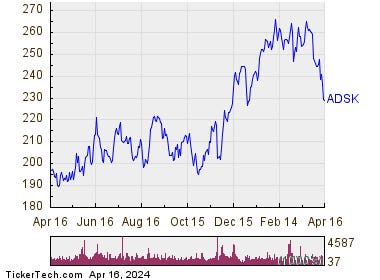Legendary investor Warren Buffett’s advice to be fearful when others are greedy and greedy when others are fearful holds true in the stock market. One way to measure fear in a stock is through the Relative Strength Index (RSI), which ranges from zero to 100. A stock is considered oversold if the RSI falls below 30.
On Monday, Autodesk’s shares became oversold with an RSI reading of 28.8, trading as low as $228.91 per share. In comparison, the S&P 500 ETF (SPY) had an RSI reading of 39.6. A bullish investor may see Autodesk’s low RSI reading as a sign that selling pressure is easing and look for entry opportunities. The chart shows Autodesk’s performance over the past year.
Autodesk’s 52-week low is $188.38 per share, while its high is $279.53. The last trade was at $229.62. Investors can keep an eye on Autodesk and other oversold stocks for potential entry points. It is important to analyze market trends and indicators like RSI to make informed investment decisions.
Investors can benefit from understanding technical analysis indicators like RSI to gauge market sentiment and potential buying opportunities. By being aware of when a stock is oversold, investors can capitalize on potential price reversals and profit from undervalued assets. Combining fundamental analysis with technical analysis can help investors make well-informed decisions in the stock market.
While no investment strategy is foolproof, Warren Buffett’s advice to be mindful of market sentiment and act counterintuitively can be valuable. By staying informed, analyzing market trends, and using tools like the RSI indicator, investors can position themselves for success in the stock market. Keeping a watchful eye on oversold stocks and potential entry points can lead to profitable investment opportunities.


